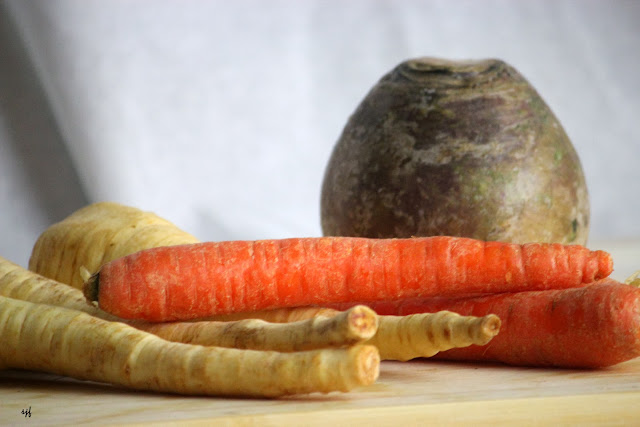Carrots
The carrot is a root vegetable, usually orange in color, though purple, red, white, and yellow varieties are available. It has a crisp texture when fresh. Carrots add sweetness and color to stews, soups, stir-fries, slaws, and cakes, plus an excellent source of Vitamin A and a good source of fiber.
Carrots are known for their rich supply of the antioxidant, beta-carotene. Research has focused on the health benefits in the areas of vision, cardiovascular disease, and cancer.
Yield: 6 servings
Serving Size: about 1 cup
Ingredients
2 cup Vegetable Broth, low sodium
1.5 cup Carrots, diced
1/4 cup Cranberries, dried, sweetened
1 box (17.6 oz) Cashew Carrot Ginger Bisque, Pacific Natural Foods
3/4 cup White Beans, unsalted, drained
Directions
Heat the vegetable broth. Add diced carrots and dried cranberries. Simmer until carrots and cranberries are tender. Using a strainer separate the carrots and cranberries from the broth. Reserve carrots and cranberries.
Combine the broth and "Cashew Carrot Ginger Bisque". Heat over medium heat until hot, stirring occasionally. Add the white beans and reserved carrots and cranberries. Mix and reheat to serving temperature.
Notes. I used a low sodium vegetable broth to lower the sodium content of the Cashew Carrot Ginger Bisque. To increase the fiber content, I garnished the recipe with white beans, diced carrots, and dried cranberries.
The carrot is a root vegetable, usually orange in color, though purple, red, white, and yellow varieties are available. It has a crisp texture when fresh. Carrots add sweetness and color to stews, soups, stir-fries, slaws, and cakes, plus an excellent source of Vitamin A and a good source of fiber.
Nutritional Information
Carrots are known for their rich supply of the antioxidant, beta-carotene. Research has focused on the health benefits in the areas of vision, cardiovascular disease, and cancer.
Recipe: Carrot Ginger Bisque
Serving Size: about 1 cup
Ingredients
2 cup Vegetable Broth, low sodium
1.5 cup Carrots, diced
1/4 cup Cranberries, dried, sweetened
1 box (17.6 oz) Cashew Carrot Ginger Bisque, Pacific Natural Foods
3/4 cup White Beans, unsalted, drained
Directions
Heat the vegetable broth. Add diced carrots and dried cranberries. Simmer until carrots and cranberries are tender. Using a strainer separate the carrots and cranberries from the broth. Reserve carrots and cranberries.
Combine the broth and "Cashew Carrot Ginger Bisque". Heat over medium heat until hot, stirring occasionally. Add the white beans and reserved carrots and cranberries. Mix and reheat to serving temperature.
Notes. I used a low sodium vegetable broth to lower the sodium content of the Cashew Carrot Ginger Bisque. To increase the fiber content, I garnished the recipe with white beans, diced carrots, and dried cranberries.
Selection.
Carrots should be firm, smooth, crisp, fresh, deep in color, and free of cuts.
Storage.
Remove tops of carrots. Store in the refrigerator up to two weeks in a plastic bag.
Serving Ideas.
1. Add shredded raw carrots to salads.
2. Add carrots to soup or puree carrots to make a carrot soup.
3. Combine cooked carrots with dried fruit
4. Snack with a low-fat dip or plain.
Resources
1. Fruits & Veggies More Matters: Carrots
2. The World's Healthiest Foods: Carrots
3. WebMD: 5 Healthy Facts About Carrots
Ensure accurate nutritional analysis for your recipes utilizing an extensive research database and over 35 years experience. A great service for the Recipe Blogger, Media, Cookbook Publishers, Writers, Chefs, and Recipe Websites. Your readers will benefit from the Nutrition information and a Registered Dietitian. Contact: Dietitians-Online.com; Sandra Frank, Ed.D, RDN, FAND at recipenews@gmail.com














